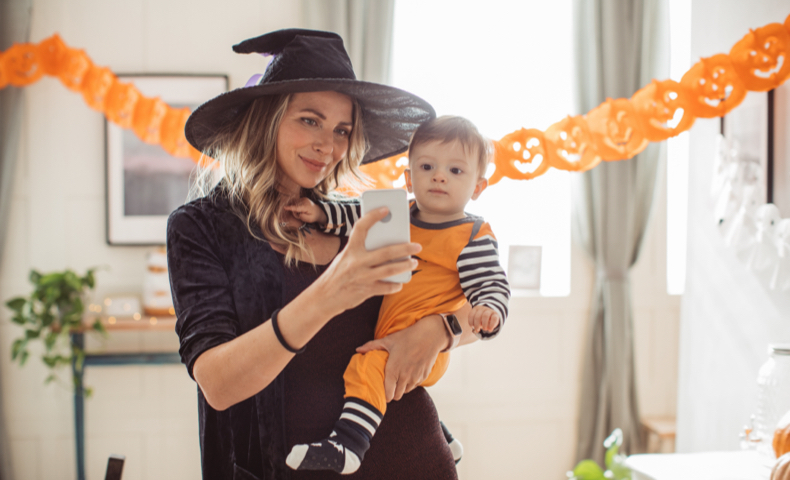
[Image description: A mother takes a selfie with her child in Halloween costumes.]
As our second Halloween of the COVID-19 era approaches, many children have had their share of scary or uncertain situations. How can you keep your kids safe while helping them focus on the fun instead of the fright?
Below are some tips to follow. But here’s an important one to start with: Check the CDC website for any updates to COVID-19 guidelines before putting your Halloween plans in motion. It’s also a good idea to find out the current levels of COVID-19 spread in your community. (Try this CDC tracker or check with your local health department.)
Trick-or-treat safely
If your children will be trick-or-treating, observe these COVID precautions:
- Limit the trick-or-treat group to members of your household.
- Stay at least 6 feet from people you don’t live with.
- Consider only visiting neighbors who leave goodies outside their doors for self-serve trick-or-treating.
- Have children 2 and older wear masks. (Costume masks don’t count!) Don’t put a cloth mask over a costume mask; it can make it hard to breathe. Instead, try incorporating a face mask into your child’s costume design.
- Use hand sanitizer between houses.
And don’t forget; the basics still apply. Make sure your kids:
- Walk in a group, accompanied by at least one adult.
- Wear well-fitting costumes that allow them to see and move easily without tripping.
- Are dressed appropriately for the weather.
- Carry flashlights and/or have reflective strips on their costumes or treat bags if they’ll be out after dark.
- Know not to eat anything from their treat bags until after you’ve inspected it (try feeding them a meal or snack before they go to reduce the temptation).
Trick-or-treat alternatives
If you’re celebrating safely at home, try these ideas:
- Organize a virtual costume parade. Invite friends and family to dress up and join from their homes. To add some good-natured competition, award prizes for funniest/scariest costumes, best background and best spooky soundtrack.
- Set up a scavenger hunt. Hide goodies or Halloween-themed items around your house or yard. Add to the fun by writing the hints as riddles or limericks.
- Scare up some spooky treats. Search craft websites for creative ways to turn everyday foods into ghosts and goblins, spiders and snakes. Look for recipes that incorporate healthy foods like fruits and vegetables, and have your children help you assemble them into Halloween goodies.
- Have a pumpkin decorating contest. Provide markers, glue, construction paper and other craft supplies for family members who are too young to carve their pumpkins. Set multiple prize categories – such as most original, most colorful and best look-alike – to create more opportunities to win.
Keep treats safe and healthy
Whether you’re handing out goodies to neighborhood trick-or-treaters, inspecting the contents of your child’s treat bag or creating foods for an at-home celebration, focus on healthy options and keep safety in mind.
- Look beyond the (candy) bag: Give out stickers, decorative notepads or pencils, or other fun items instead of sweets.
- Make healthy treats for your household. Homemade food items aren’t good to give away (more on that below). But for your own family, creative snacks like mandarin orange “pumpkins” with celery stems, or kiwi slices decorated as green-faced monsters, definitely get the thumbs up!
- Inspect incoming goodies. If your kids trick-or-treat, check the contents of their bags before letting them eat from it. Toss out anything that is homemade or unwrapped or has a wrapper that’s open or damaged. If your child has food allergies, remove anything that contains substances they’re allergic to. Then set limits on how many pieces your child can have from the bag each day until it’s empty.
- Negotiate a candy buyback. Some dentists’ offices and other organizations pay kids cash for their Halloween candy and donate the haul to soldiers serving overseas. If you can’t find a buyback program near you, create your own by exchanging your child’s candy for a healthier item they have their eye on.
Finally, if your child isn’t feeling well, keep them home from trick-or-treating. And if you’re not sure whether that stomach upset is candy-related or something else, LiveHealth Online doctors are available to help.
Recommended Posts


